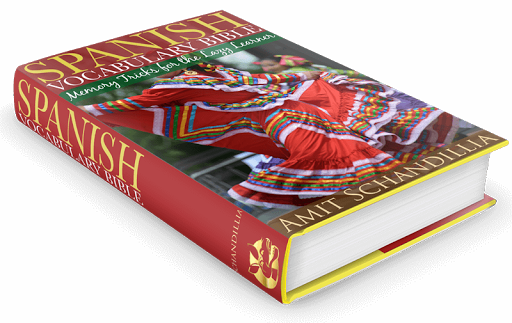 |
| Parts of your body in Spanish |
| Photo credit: Translation from English drawing via Wikimedia Commons licensed CC BY-SA 3.0 and GFDL |
The parts of our body
arm — brazo (imagine a giant medieval statue with brass arms holding a torch and a tablet reminding you of the Statue of Liberty)
back — espalda (that girl wearing a backless dress doing a seductive pole dance revealing her bare back)
brain — cerebro (if you remember your tenth grade Biology, cerebrum is the scientific term for brain in English)
breast, chest — pecho (imagine Schwarzenegger’s chiselled pecs)
buttocks — nalgas (visualize a man with a huge ass that looks full of anal gas, or fart! I know, sounds gross but if that makes it stand out, so be it)
calf — pantorrilla (imagine seeing a short-pants-clad gorilla flaunting his strong calf muscles)
ear — oreja (imagine a mentally deranged serial-killer who has his victims’ ears stored in a glass jar! Why ears? Maybe he lost his hearing in an accident when young and that scarred him for life?)
elbow — codo (how would the English alphabet sound if it started at “l” instead of “a” and except for the first letter, ended in an /o/ sound? It would go somewhat as, “el-bo-co-do...” instead of “ay-bee-cee-dee.”)
eye — ojo (picture the 2 o’s of ojo as 2 eyes and the j as nose! Besides, doesn’t ojo look like an owl with large eyes if you look hard enough?)
finger/toe — dedo (don’t your fingers feel numb and dead in Antarctica?)
foot — pie (imagine dashing across the room in a rush and accidently stepping upon a dish of apple-pie lying on the floor; your mom made it with so much love and you messed it up; you, reckless you!)
hair — pelo (you are losing a lot of hair if you see strands on your pillow)
hand — mano (Robinson Crusoe’s right-hand was Man Friday)
head — cabeza (that ugly monster’s head looks like a cabbage)
heart — corazón (remember the song by Ricky Martin? In case you don’t, think of your heart as the core zone of your body; without it, you are dead)
hip — cadera (I know someone so huge that his hips got stuck in the caldera of Mount Vesuvius...some giant, fire-proof monster who lives inside a volcano and emerges from its mouth once in a year?)
knee — rodilla (walking down the road, I met a gorilla kneeling on his knees; he could be trying to impress me so I would throw some fruits at him)
leg — pierna (if you remember that pie is foot then pierna should be easy to remember too)
mouth — boca (ever heard of the buccal cavity in Biology?)
neck — cuello (the English word, collar, has the same Latin root as the Spanish cuello so it should not be difficult to correlate and recall)
nose — nariz (an accident in Arizona gave me a broken nose)
shoulder — hombro (imagine a man, un hombre, with broad shoulders; anyways, its generally accepted that men have broader shoulders than women)
skin — piel (how would you feel having your skin peeled off? Painful? Let this pain help you retain and recall this word)
thigh — muslo (imagine a sprinter’s muscular and well-toned thighs and this time, let your envy help you remember the word)
throat — garganta (gargling is good for sore throat)
tongue — lengua (to speak any language, you need a tongue that’s why your native lingo is called your mother tongue)
Imagination is a personal faculty
Spanish vocabulary with visualization and mnemonics is a recipe for success. Compared to traditional methods, they work like charm and last a lifetime. I have often stressed that the visualization cues or mnemonics given here are personal to me. I invented them so, by nature, it’s me who’s going to benefit the most from them. Why? Because human minds are highly personalized and work differently when it comes to imagining things. an image that might be familiar to one person’s mind might be totally alien to another. these differences in perception are driven by many factors and your cultural background and mother tongue are two of those.
Hence, the lesson here is that while I have given you the cues that worked for me, I would encourage you to use these hints purely for the purpose of understanding the trade and then invent your own personalized cues. That way, you will benefit more and recalling new vocabulary would get less stressful. Whatever you choose to do, make sure your visuals are as vivid and uncanny as it gets.



.png)